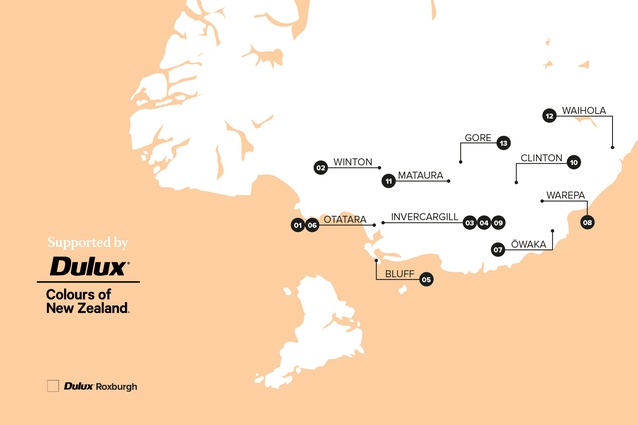Itinerary: Monica F Barham in Southland
In this month’s itinerary, supported by Dulux Colours of New Zealand, Megan Rule highlights 13 projects by Monica F Barham, the first Itinerary in a series dedicated to a singular female architect’s practice work.
The writing on New Zealand women architects’ practice from the 20th century has, until recently, been woefully scant. This Itinerary is the first in a series, each dedicated to a singular female architect’s practice work. Monica Barham is arguably the first registered female architect to practise as a partner in a successful architectural business in New Zealand, doing so with architect husband Cecil Barham from 1946.
Between 1945 and 1975, Invercargill’s post-war population doubled. Cecil Barham had turned down an opportunity of partnership in Monica’s father’s practice, Allan C Ford Architect, as he wanted, with Monica, to practise as equals sharing all aspects of the business. Together, they established Barham and Barham Architects and, at the same time, raised their six children. The Barhams’ practice thrived, fuelled by demand for public and community buildings, infrastructure and housing.
From a job list reaching almost 500, the Barhams each led their own separate projects and they also worked together on projects. Monica Barham was involved in all aspects of architecture in the practice: attracting new clients, structural design, working drawings and site administration. Journal listings for projects show Monica’s initials first. Hand-drawn and water-colour presentations reveal a subtle variance in their work. Monica was responsible for bringing licensing trust work into the office, along with a series of projects near to their Otatara home studio. While, typically, all the projects discussed here were collaborative with Cecil, two-thirds of them were led and/or drawn by Monica, as indicated at the top of the listings over-page.
Arts and Crafts and Art Deco influences appeared in Monica Barham’s early work, probably reflecting her apprenticeship in her father’s practice while studying extramurally from the late 1930s at Auckland University College.
A 1925 design competition for the Auckland University College Arts Building, home to the Architecture School in ensuing decades, heightened local interest in a ‘rural prairie school’ genre emanating from America. This influence had travelled via Sydney and Canberra with Marion Mahony Griffin and Walter Burley Griffin, and arrived on New Zealand shores with the Griffins’ associates, Roy and Genevieve Lippincott, after Lippincott and Bilson won the design competition. The Barhams’ own ‘terraced residential unit’, Telesis, on their rural property signalled their shared interest in the American direction of Frank Lloyd Wright faithfuls with a modern interpretation.
Monica Barham’s work prioritised human needs, apparent in her community buildings with their services, and rural or country homes favouring the housewife’s and, thus, the family’s, harmony. The building configurations were practical, placing importance on economy, services, adaptability and convenience but, also, relating sensitively to local climate and context.
Decorative glass and steel featured in the Barham repertoire as the practice enriched a materiality in concrete and stone, together with locally available timbers. A post-war direction delivered more tectonic language, often with pattern, suggesting an increasing durability in masonry form. This transitioned in a later phase to a refined modern touch in predominantly timber compositions and elements, elevating the lightness and fluidity of spaces.
In 2023, the 1956 Don Street Medical Centre in Invercargill received a New Zealand Institute of Architects Enduring Architecture Award. It becomes the earliest known building by a female architect to have received an NZIA architecture award, as it was completed 10 years prior to the Lillian Chrystall-designed Yock House in Remuera, Auckland (1964–1966), which earned a Bronze Medal in 1967 and has previously been identified as the earliest recipient. Both awards were received within partnership practices with the architects’ partners in life.
BIOGRAPHY
Biography Monica Barham (née Ford; 1920– 1983) was born in Dunedin, attending high school at Southland Girls’ High School and, later, Columba College in Dunedin. In 1937, aged 17, she began her career as an architectural draughter in the Invercargill office of Allan C Ford Architect, later Ford, Gray and Derby Architects, before completing a Diploma in Architecture at Auckland University College in 1944. A C Ford was best known in the city for his art deco work, such as the Cambridge Arcade, and for his arts and crafts residences.
On return to Invercargill in 1945, Monica Ford became the first woman registered architect in the Southland and Otago Branch of New Zealand Institute of Architects. At the same time, she successfully completed her registration with the Royal Institute of British Architects.
Monica Barham was also an avid artist. She supported local art, producing sculpture and paintings, and taught art at Southland Boys’ High School and James Hargest College from the late 1960s. She became chair of the former Anderson Park Art Gallery in the early 1970s. Her watercolour paintings are held in the Invercargill Public Art Gallery.
THE ITINERARY

01. 1947 – Barham Residence
Taiepa Road Otatara, Invercargill
Led and/or drawn by Monica Barham
The Barhams purchased their property, Telesis, as the site on which to build their new family residence. An architect’s own home can be a testing ground for ideas, with importance placed here on practical, functional requirements in rural conditions and a more modern response to the needs of the family. Scandinavian and American design influences are evident in optimal site orientation, materials and the use of the sun to heat the house, earth to shelter the building, weather lobby zones and clerestory daylighting. The Barhams’ home was adapted over time to suit their expanding family and still exists largely unaltered.
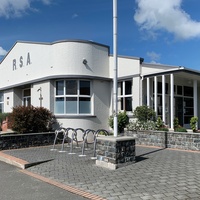
02. 1950 – Winton RSA Clubrooms
186 Great North Road, Winton
Led and/or drawn by Monica Barham
The Winton RSA Clubrooms, an elegant Art Deco, single-storey building, exemplifies the Barhams’ early practice. Largely unaltered, and renovated in the last decade, it is described in The Southland Times of 24 April 2016 as a “seriously impressive building, warm, lively and inviting”. A curving, streamlined and modulated exterior building form on the north elevation creates a generous, sunny, semi-public courtyard off the main street, adjacent to a bakery. The interior exudes its own charm and human scale with timber panelled walls, adaptable mobile walls and built-in joinery fittings.
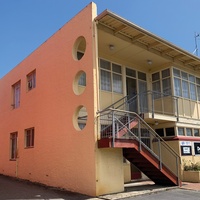
03. 1956 – Don Street Medical Centre
69 Don Street, Invercargill
Led and/or drawn by Monica Barham
The 2023 Southern Architecture Awards jury describes “An elegant modernist 1950s’ doctors’ rooms completed by a prominent and prolific young architect. A sleek, streamlined form of concrete, circular openings and fine steelwork, these rooms are a true reflection of their time. This architectural result is restrained and simple and recognises the influence of international modernism in New Zealand.” The modern medical centre, built for Dr F Russell Millar, features a distinctive motif of circular concrete wall voids that mark the entry and anchor the building together with a steel-screened stair. See Architecture NZ Sept/Oct 2023
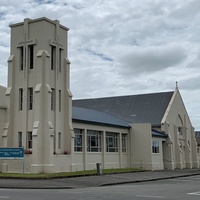
04. 1957 – St Peter’s Methodist Church
158 Elles Road, Georgetown, Invercargill
Led and/or drawn by Monica Barham
In St Peter’s Methodist Church, later the Elles Road Bible Chapel, the nave is a modern concrete masonry addition to an historic Gothic church, come hall, rectangular in shape and filled with natural light. The window surfaces incorporate themed sandblasted art motifs of biblical stories. A smooth, curved wall envelops the entry like a rippling piece of fabric with details that link to the original church. The bell tower marks the street corner, with garden planters and vertical decorated shadow lines that speak of a regional ‘prairie’ genre. The historic exposed Gothic buttresses are respectfully acknowledged in the tower detai
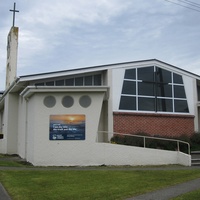
05. 1958 – Bluff Methodist Church
56 Foyle Street, Bluff
Barham and Barham Architects
The Bluff Methodist Church tucks into the hillside, its flowing steps falling against integrated planter boxes. Its windows, at a high level for daylight and air ventilation, borrow material references from a neighbouring primary school, a nod to brick relief patterns. The unusual symmetrical double-winged corner entry has nautical motif windows. The short axis orientation of the church space seems counter-intuitive but manages to balance the use of space with a prominent tower relationship and internal circulation flow.

06. 1961 – Otatara Plunket
14 Allan Street, Otatara, Invercargill
Led and/or drawn by Monica Barham
The Barhams were part of a growing seaside neighbourhood during a babyboom period. This type of commission no doubt emanated from their family connections with local community activities. The corner site layout lent itself to a complementary public-facing commercial retail addition, indicated by an exterior concrete firewall as part of the design. Adaptability or a staged approach to community buildings recurred in their work. The building is no longer occupied by the Plunket Society but has been colourfully adapted for re-use as a residence.
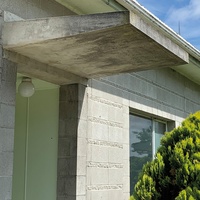
07. 1962 – Ōwaka Presbyterian Church
12 Main Road, Ōwaka
Led and/or drawn by Monica Barham
One of a series of commissioned churches, Ōwaka Church demonstrates the Barhams’ interest in exploring the capabilities of concrete masonry with purity in the cantilevering of structural elements like a roof over the entry and crafted horizontal variation in masonry patterning visible to the lingering eye. Appreciation for the level of detail achieved is made even more poignant by its absence in a later expanded floor plan addition. Entry joinery is reutilised, though walls revert to a standard masonry finish. The spire is finely detailed with shiny vertical ornamentation to accentuate its height.
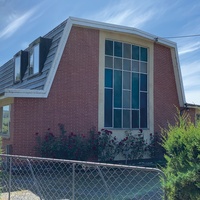
08. 1964 – Warepa Presbyterian Church
389 Old Port Road, Warepa
Barham and Barham Architects
With a structurally ambitious and innovative form, a series of ascending steel frame knee-joined portals accentuate the interior perspective. Exposed diagonal internal timber facings in the nave suggest bracing strength and moderation of acoustic ambience. An adjacent hall is joined with a curved frontage. Situated in the countryside, the building has, in the last decade, been sympathetically converted to a residence and art studio. Dormer windows added into the upper volume of the nave are the only external hint of bedrooms fitted into this voluminous space.

09. 1964 – F R Millar Residence
8 Montrose Street, Gladstone, Invercargill
Led and/or drawn by Monica Barham
Dr F R Millar commissioned the Barhams to design a house located at what was then the northern edge of the city. The home encompassed a number of thoughtful, time-saving, comfort-enhancing details, from the fuel box basement lift mechanism and horizontal hot-water storage, to an extensive interior fit-out and modern features that improve the convenience of household activities. This house, laid out around a partial courtyard, is largely unchanged. Monica’s hand fully describes virtually every detail in a typically brief set of drawings.
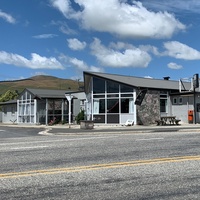
10. 1966 – Oak Tree Inn (now Crossroads Clinton Café Bar Restaurant Motel)
1 Gorge Road, Clinton
Led and/or drawn by Monica Barham
Commissioned for the local licensing trust, this tavern occupies a prominent intersection to capitalise on road vistas and the sun’s northern path. Gabled roof forms to public spaces address their road frontages in ‘alpine’ fashion while also creating acoustic perforated baffles and daylight-filled atmospheric volumes. Exposed masonry walls to main road frontages feature crazy stone veneers. A corner café ensures daytime atmosphere and activity. The hotel functions are largely unchanged except for kitchen relocation, with even the original refined mid-century modern timber cabinetry retained in the hotel units.
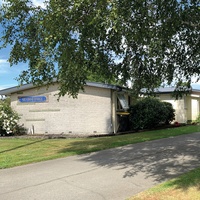
11. 1967 – Mataura Pensioner Flats
54 Main Street, Mataura
Barham and Barham Architects
The Barham pensioner flats are a steadfast part of the community landscape in a town once dominated by a paper mill near the river falls and a revitalised freezing works. The flats are well positioned between the main SH1 and rail trunk line overlooking, to the north, a town reserve marked with a single central tree and a thriving minimart. With their diamond plan configuration, the compact, single-level units are oriented for sun, street activity and the shopping area. Angular unit relationships assist in maximising privacy and view lines: a precursor to the 45-degree-angle offset plans more common in the 1980s.
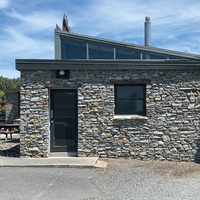
12. 1969 – Lake Waihola Tavern (now Lake Waihola Tavern & Restaurant)
29 Greenwich Street, Waihola
Led and/or drawn by Monica Barham
The Lake Waihola Tavern marks a later phase in the Barhams’ practice. The tavern’s originally proposed organic structure of concrete trees was arranged around a unifying hexagonal core, with further elements radiating out from a central hub. That design proved to be too ambitious so the built version is scaled back to a rectilinear composition forming a garden court. More recently, schist cladding has been added to the building frontage, encouraging nostalgic links to Otago’s earlier heritage. Internally, the outdoor courtyard has had a lightweight roof added. Following a fire in 2009, the Tavern was reinstated.
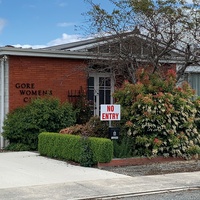
13. 1969 – Gore Women’s Club
6 Lyne Street, Gore
Barham and Barham Architects
The street façade exudes warmth in a red brick finish, with a generous central entry porch flanked by wrought-iron gates. A well-tended planter box greets visitors, softening the simple, robust, exposed concrete masonry form of the remaining elevations. A setback roof gable and clerestory window add further depth to the street elevation. The main meeting room benefits from having a skillion roof, with increased ceiling height and natural light. Room arrangements can comfortably accommodate meetings or gatherings of a range of scales.
OTHER ADDRESSES
Centennial Rest Rooms (1958) — 10 Onslow Street, Bluff
The entire north wall featured modern, glazed joinery with a matching industrial-style inclined clerestory above. A generous porch opened onto the local park. The north elevation was later modified with an addition to house the Bluff Senior Citizens Association. (Monica Barham led/drawn).
Stewart Island Centennial Museum (1960) — 7 Ayr Street, Stewart Island
In 2020, a new museum opened nearby so the original, altered building has now been converted into a café and residence. See Stewart Island News, April 2020, p. 7.
Mataura Library (1969) — 8 McQueen Avenue, Mataura
A Scandinavian alpine influence appears with streamlined fascia linings. The simple rectilinear form, with recessed corner entry, has a low-pitched gable roof, tapering skillion ceiling line and gable-end glazing.
DEMOLISHED
Brown Owl Milk Bar (1948–1953) — 128 Esk Street, Invercargill
Monica’s art and interiors feature in a curved bar and her own sandblasted decorative panels. Closed in 1953, it became part of a major Invercargill city block demolition in 2020, making way for a new retail mall. See New Zealand Home & Building Dec/Jan 1948, pp. 49–51. (Monica Barham led/drawn).
Barham Holiday Cabin (1970) — 4 Cemetery Road, Queenstown
This modern alpine holiday cabin resembled the Barhams’ Mataura library. The cabin was dismantled and removed from site in 2020. (Monica Barham led/drawn).
SOURCES
Elizabeth Cox’s landmark survey of influential female architects, Making Space: A History of New Zealand Women in Architecture (MUP, 2022), includes a dedicated chapter on Monica Barham. Research materials on the practice are available in the Architecture Archive, Libraries and Learning Services, the University of Auckland, including: the Barham and Barham Collection; Robin Skinner’s unpublished report, ‘Monica Barham – Architect’, prepared for the University’s Women in Architecture course (1993); and the Sheppard Collection files. Norman Ledgewood’s Southern Architects: A History of the Southern Branch, New Zealand Institute of Architects (Southern Branch NZIA, 2009) and The Southland Times are also useful in providing information on local projects.
Click here to learn about the He Waka Tua exhibition on Monica F Barham taking place in Invercargill 11 May–16 June 2024.

The Itinerary series is supported by Dulux Colours of New Zealand. Dulux Colour Specialist Davina Harper has selected a Colours of New Zealand palette based on this itinerary. See the full range and order colour samples here.



